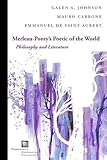Merleau-Ponty's Poetic of the World : Philosophy and Literature / Galen A. Johnson, Emmanuel de Saint Aubert, Mauro Carbone.
Material type: TextSeries: Perspectives in Continental PhilosophyPublisher: New York, NY : Fordham University Press, [2020]Copyright date: ©2020Description: 1 online resource (256 p.)Content type:
TextSeries: Perspectives in Continental PhilosophyPublisher: New York, NY : Fordham University Press, [2020]Copyright date: ©2020Description: 1 online resource (256 p.)Content type: - 9780823288151
- 801.9 23
- B2430.M3764
- online - DeGruyter
| Item type | Current library | Call number | URL | Status | Notes | Barcode | |
|---|---|---|---|---|---|---|---|
 eBook
eBook
|
Biblioteca "Angelicum" Pont. Univ. S.Tommaso d'Aquino Nuvola online | online - DeGruyter (Browse shelf(Opens below)) | Online access | Not for loan (Accesso limitato) | Accesso per gli utenti autorizzati / Access for authorized users | (dgr)9780823288151 |
Frontmatter -- Contents -- Preface -- Abbreviations of Works by Maurice Merleau-Ponty and Other Writers -- Introduction -- PART I: MERLEAU-PONTY' S POETS -- 1 "The Proustian Corporeity" and "The True Hawthorns": Merleau-Ponty as a Reader of Proust between Husserl and Benjamin -- 2 A Poetics of Co-Naissance: Via André Breton, Paul Claudel, and Claude Simon -- 3 From the World of Silence to Poetic Language: Merleau-Ponty and Valéry -- PART II: MERLEAU-PONTY' S POETICS -- 4 The Clouded Surface: Literature and Philosophy as Visual Apparatuses According to Merleau-Ponty -- 5 Metaphoricity: Carnal Infrastructures and Ontological Horizons -- 6 On the Poetic and the True -- Acknowledgments -- Notes -- Index
restricted access online access with authorization star
http://purl.org/coar/access_right/c_16ec
Merleau-Ponty has long been known as one of the most important philosophers of aesthetics, yet most discussions of his aesthetics focus on visual art. This book corrects that balance by turning to Merleau-Ponty's extensive engagement with literature.From Proust, Merleau-Ponty developed his conception of "sensible ideas," from Claudel, his conjoining of birth and knowledge as "co-naissance," from Valéry came "implex" or the "animal of words" and the "chiasma of two destinies." Literature also provokes the questions of expression, metaphor, and truth and the meaning of a Merleau-Pontian poetics.The poetic of Merleau-Ponty is, the book argues, a poetic of the flesh, a poetic of mystery, and a poetic of the visible in its relation to the invisible. Ultimately, theoretical figures or "figuratives" that appear at the threshold between philosophy and literature enable the possibility of a new ontology. What is at stake is the very meaning of philosophy itself and its mode of expression.
Mode of access: Internet via World Wide Web.
In English.
Description based on online resource; title from PDF title page (publisher's Web site, viewed 02. Mrz 2022)


